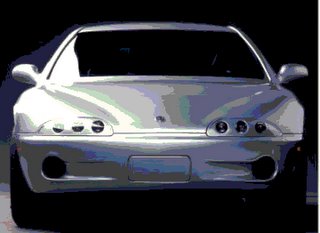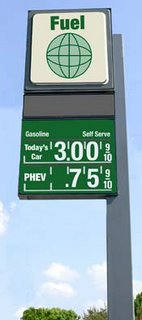 Coalition Turns On to 'Plug-In Hybrids'
Coalition Turns On to 'Plug-In Hybrids'Utilities, Localities, DaimlerChrysler Give Traction to Professor's Drive For High Mileage
By JOHN J. FIALKA Staff Reporter
THE WALL STREET JOURNAL
January 25, 2006
DAVIS, Calif. -- In the 1950s, an aspiring Pasadena hot-rodder named Andrew Frank shocked the competition by powering his 1936 Ford with a Cadillac V-12 engine. "It had gobs of torque," he recalls.
In the 1990s, as a mechanical-engineering professor at the University of California here, Dr. Frank produced another shocker. He yanked big engines out of American cars and replaced them with electric motors that worked in tandem with much smaller gasoline engines. He called his new configuration the "plug-in hybrid" because it allowed homeowners to recharge the car's batteries by plugging into an electrical outlet.
Hybrid automobiles work with two engines. Auto makers have tinkered with them since the early 1900s, but the cars didn't gain much attention in the U.S. until Japanese companies began selling them in 1999. The current top seller is Toyota Motor Corp.'s Prius; Americans bought 205,790 of them last year. What Dr. Frank was proposing more than 10 years ago, however, was a variation on the hybrid theme.
But Detroit auto makers ignored him. Japanese car makers, about to market their own hybrids that didn't plug in, paid scant attention. This year, however, as hybrids have gained in popularity amid high gasoline prices, Dr. Frank, now 72 years old, is getting some traction:
A U.S. coalition led by electric utilities, sensing a way to gain market share through vehicles that derive 90% of their power from electricity and can recharge at night when power is plentiful and cheap, kicked off a national campaign in Washington yesterday to push auto makers to make plug-in hybrids.
Some cities, environmental groups and state pollution regulators have joined this "
Plug-in Partners" effort. They see plug-ins as a means to meet tightening air-pollution standards and to use controls over utilities as a way to clean up urban air.
DaimlerChrysler AG has turned a European delivery van, called the Sprinter, into a prototype diesel-electric plug-in. Forty of the vehicles will be tested over the next two years by a variety of U.S. agencies and companies.
The plug-in campaign is intensifying just as car buyers and policy makers are grasping for ways to ease the nation's energy problems. When President Bush delivers his State of the Union address next week, he is expected to tout alternative auto fuels, like ethanol, as well as nuclear energy.
A key difference between plug-in hybrids and conventional hybrids is that plug-ins have a bigger battery pack and can be designed to run a passenger car on electricity for the first 60 miles -- about the length of an average daily commute.
Dr. Frank estimates that if drivers regularly recharge their batteries at home, plug-ins may get well over 100 miles per gallon. By comparison, conventional hybrids must rely on gasoline-powered engines to recharge their batteries and get between 40 and 60 mpg.
While running on electricity, the plug-in's fuel cost drops to 70 cents a gallon, or lower, Dr. Frank estimates.
Only a handful of experimental plug-ins are on the road. Some auto makers say the vehicles are more vulnerable to wear and tear than other hybrids. The biggest government spenders on auto research, the federal government and the state of California, remain focused not on hybrids but on fuel-cell-powered cars that use hydrogen.
"You should take a look and see at least what the federal government is thinking," Dr. Frank told students in one of his graduate classes recently, adding with a smile and a wink, "I don't agree with most of what they have to say." In the basement of his school's engineering building, Dr. Frank and his students tinker with sport-utility vehicles.
Their first move with a Ford Motor Co. Explorer was to rip up its floor panels. "Most cars have plenty of underutilized space," Dr. Frank explains, showing how he and the students filled that space with batteries.
Then the students replaced the Explorer's big gasoline engine with a fuel-sipper taken from a General Motors Corp. Saturn and a 200-horsepower electric motor. Power from the two engines, which operate on the same drive shaft, is controlled by a continuously variable transmission, a gearless, computer-controlled device. Dr. Frank estimates that the car's weight remains about the same. The batteries he puts in make it heavier, but his engines and transmissions are lighter than the ones he removes.
Dr. Frank's hybrids have enough electric power to run for the
first 60 miles; then, computers turn on the gasoline engine to help run the car and keep the batteries charged. Dr. Frank's students have discovered that even with six of them riding in the Explorer, it could still "burn rubber."
That was the Explorer's downfall last year in an annual contest held by the Department of Energy to see which American university could build the most efficient-running car. Dr. Frank's students were showing off the car's acceleration in the parking lot before the contest, when it died. "We broke the motor," he explains.
In June, U.C. Davis will try again with a Chevrolet Equinox, powered by a relatively tiny Toyota Prius gasoline engine and electric equipment similar to that in the Explorer. To demonstrate that cars can be weaned almost entirely from fossil fuel, Dr. Frank's students plan to run the gasoline engine mainly on ethanol made from corn. They are designing a tent with solar panels that can be used to recharge the batteries.
Utilities are drawn to the idea of a car that plugs in at home. The Electric Power Research Institute, which is financed by utilities, is sponsoring DaimlerChrysler's experiment with plug-in delivery vans. The project is being shepherded one of Dr. Frank's former students, Mark Duvall, who remembers working long nights modifying cars in the professor's lab. "He was a complete master of giving you enough rope to hang yourself," Mr. Duvall says.
Critics say the plug-in's weak point may be its batteries, which could burn out if power is drawn up and down frequently. Dr. Frank says recent experiments with electric cars by Toyota and GM have developed batteries that can stand the strain.
Dan Benjamin, a transportation analyst for ABI Research, an Oyster Bay, N.Y., market-research firm, says the battery problem means plug-ins will appear first as commercial vehicles: "Stop-and-go city driving really takes advantage of this technology."
Bill Kwong, a spokesman for Toyota, says the company doesn't encourage buyers of its hybrids to use kits, made by some companies, that convert them into plug-ins, since "it cycles the batteries down way too deeply and shortens the life of the batteries." For that reason, he says Toyota isn't working on a plug-in hybrid.
Others think the car will be too expensive. It costs Dr. Frank about $100,000 to customize a car. But he estimates that made in volume, his adjustments would raise the cost of a car by a more affordable 25%. He says most plug-in parts could be made by a well-equipped machine shop.
The plug-in feature will add from $4,000 to $6,000 to the cost of a car, he calculates, noting "that's what some people pay for a sunroof, leather seats and a fancy navigation system."








